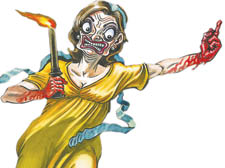|
|
 |
| |
‘Lady Macbeth Cherie,’ flirty first lady of Downing Street
The latest account of the inside story of ‘Toblerone’ Tony and Shakespearean Cherie is both fascinating and shocking,writes Geoffrey Goodman
The Darlings of Downing Street
by Garry O’Connor. Politico’s £18.99.
OVERSHADOWED by the massive publicity surrounding the launch of Alastair Campbell’s diaries of his life and times with the Blairs, this Garry O’Connor version of life with Tony and Cherie has been unfairly sidelined.
The result is the book still struggles to be taken seriously. This is a considerable mistake since O’Connor has produced a surprisingly different, and highly readable, study of Mr and Mrs Anthony Blair’s extraordinary 10-year residence in Downing Street – years in which that focal point of British political life was too often turned into a circus for craven showbiz celebrity.
Indeed what O’Connor’s book achieves with his somewhat misleading sub-title of ‘The psychosexual drama of power’ is to take us frequently behind the veil of political respectability, almost metaphorically, to between the sheets of the Blair marriage.
O’Connor does this without in any sense being intrusively squalid or offensive, but succeeds notably in demonstrating what a confused, contradictory, negative, intelligent albeit pretentious, and very insecure person resides within the psyche of Cherie Blair.
O’Connor clearly regards her as having been ill-equipped for the role of first lady of Downing Street and concludes that she was a hindrance rather than a political support to her husband, whose own inadequacies required a woman partner made of sterner political material.
His final label for Mrs Blair is as the Lady Macbeth of Downing Street. This analysis alone is an important reason why O’Connor needs to be read in conjunction with the Campbell diaries. Together they provide a flavour of Blairism in power that is unlikely to be bettered.
What is especially interesting is the author’s reason for choosing his subject. Garry O’Connor is not a political pundit and makes no claim to be writing a definitive history or political biography. He also disclaims any firm political beliefs. His principal objective is to examine the psyche and the personalities of those who seek to handle power.
Unlike the former distinguished Labour MP Leo Abse, who now specialises in psycho-biography, O’Connor has no ideological axe to sharpen – though he does use Abse’s books extensively to reinforce his own psycho-analytical observations.
O’Connor is an authority on the Roman Catholic Church and has written an acclaimed biography of Pope John Paul II – as well as books on the stars of the theatre such as Peggy Ashcroft, Alec Guinness and Ralph Richardson. So he has important reflections on Cherie Blair’s involvement with the Church of Rome as well as Tony Blair’s restless search for a suitable god.
This may explain why O’Connor managed to obtain a brief interview with Cherie Blair (he never sought an interview with the Prime Minister). The author describes a bizarre one-to-one with the Prime Minister’s wife with her almost flirting with O’Connor. He insists he is not fantasising with his picture of the scene in the sitting room of the Blair’s flat in the upper part of 11 Downing Street: “She [Cherie Blair] was at pains to let me see her warm, lovely, human side, but there was a kind of labile openness, almost, but not wanting to put it too crudely, a flirty
looseness about her which I found quite disconcerting, and which she played on. It would have been more expected, say, in a young actress meeting her director for the first time.”
My reading suggests that O’Connor became both fascinated with,as well as appalled by, Mrs Blair.
As with Alastair Campbell, one of O’Connor’s principal targets for criticism, and puzzlement, is the way Cherie Blair allowed Carole Caplin to become a close confidante. He is equally amazed at the casual way in which the Prime Minister accepted Caplin’s perpetual presence despite all the warning signals about her dubious influence on Cherie. O’Connor is in no doubt that the entire relationship between Cherie Blair and Caplin was extremely unhealthy – which, of course, echoes the views of Alastair Campbell and his partner Fiona Millar who quit working w ith Mrs Blair because she refused to break with Caplin.
What is also astonishing, according to this book, is that as late as 2006 Carole Caplin “continued to hold midnight telephone conversations with Tony whom she called ‘Toblerone,’ giving him fashion advice, diet tips and feedback on his television appearances even while she was no longer on speaking terms with Cherie”. Yet perhaps the most extraordinary story of all in this book is how Cherie Blair persuaded the church to come to Downing Street, rather than confront the inconvenience of attending Mass in Westminster Cathedral.
It is indeed a disturbing revelation. Toward the end of Blair’s premiership the family no longer felt able to attend public Mass at the Cathedral, which is only a few minutes’ stroll from Whitehall.
Cherie arranged for the church to send a priest to Downing Street.
He slipped in through the back door to the private flat where the Blair family, sitting on sofas, were “gathered round the coffee table in rapt devotion to receive the sacrament from the chalice”.
I can offer only one comment on this extraordinary story – which I assume to be true: It is pure Monty Python.
|
| |
|
 |
|
| |
 |
|
 |
|



